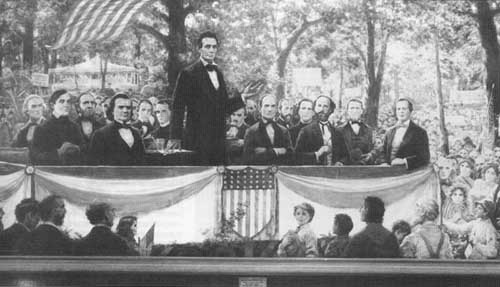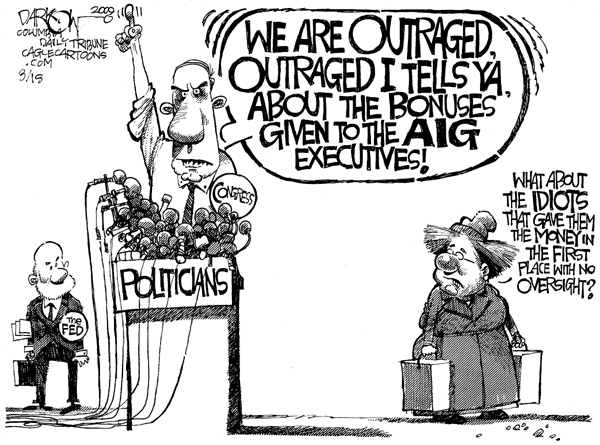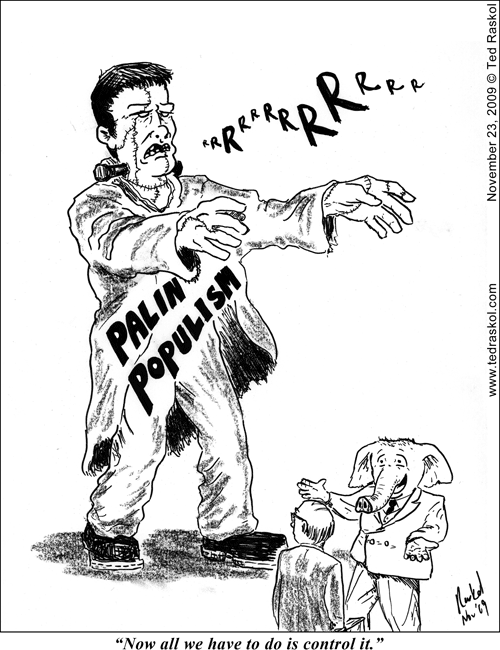 The sixth party system is a label to categorize the political party dynamic in present day America. Others have posited that this system either has not started yet, or began when LBJ signed the Civil Rights Act, forfeiting the South electorally. I contend this most recent system actually began in the late 1980s to early 1990s when both parties began to ideologically homogenize. This process has seen both parties purge themselves of moderates and ideological minorities. Others have contended that America has moved from a four party system, with a left and right-wing of each party, to a simple two party system. This new party discipline resembles parliamentary politics, which conflicts with the necessity for bipartisanship in America’s divided powers. This has noticeably taken shape within the Democrat Party as southern, conservative Democrats have grown scarce. In the Republican Party, liberal Republicans, such as Jacob Javitz, are now completely extinct. Only a handful of moderate Republicans currently exist, with more and more retiring each election cycle (Former Senator of Ohio George Voinovich being the most recent). This dynamic culminated in the Clinton versus Gingrich government shutdown of 1995, and the narrow agendas of each party in the current political atmosphere. Once an electorate chooses a side, the winner deems it as a mandate to pursue their most controversial agenda items, instead of the true cause of electoral shifts: dissatisfaction with both sides.
The sixth party system is a label to categorize the political party dynamic in present day America. Others have posited that this system either has not started yet, or began when LBJ signed the Civil Rights Act, forfeiting the South electorally. I contend this most recent system actually began in the late 1980s to early 1990s when both parties began to ideologically homogenize. This process has seen both parties purge themselves of moderates and ideological minorities. Others have contended that America has moved from a four party system, with a left and right-wing of each party, to a simple two party system. This new party discipline resembles parliamentary politics, which conflicts with the necessity for bipartisanship in America’s divided powers. This has noticeably taken shape within the Democrat Party as southern, conservative Democrats have grown scarce. In the Republican Party, liberal Republicans, such as Jacob Javitz, are now completely extinct. Only a handful of moderate Republicans currently exist, with more and more retiring each election cycle (Former Senator of Ohio George Voinovich being the most recent). This dynamic culminated in the Clinton versus Gingrich government shutdown of 1995, and the narrow agendas of each party in the current political atmosphere. Once an electorate chooses a side, the winner deems it as a mandate to pursue their most controversial agenda items, instead of the true cause of electoral shifts: dissatisfaction with both sides.
This new system is typified by heavy partisanship, strong party discipline in voting, and legislative gridlock. It is as much caused by social migration, incumbent friendly redistricting, and party primaries as much as changes among political parties and actors.
This blog will be used to explain this new system, with infusions of political commentary, observations, electoral predictions and other characterizing modes of this system. I will also comment on gridlock and partisanship as it occurs on a daily basis, since in my eyes these are the defining products of the sixth party system.
Just to provide some contextual background, here are the previous 5 party systems and their dominant characteristics:
 The First Party System (1789-1833)
The First Party System (1789-1833)
Began as intra-party differences between the pro-federal expansion Hamiltonians and the rural, state-centric Jeffersonians. Theses factions evolved into America’s first parties: the Federalists and Anti-Federalists. During the peek of their rivalry, numerical parity was pervasive and party discipline was fairly low. The Anti-Federalists drew from the former anti-constitutionalists as well as former Federalists (like James Madison) who were strict in their constitutional scope, leading to a retraction from supporting further federal powers. The Anti-Federalists became the Democratic-Republicans by the time Secretary of State Jefferson ran for president to succeed Washington, but losing to Federalist Vice President John Adams (Note: Like Washington, Adams did not favor factionalism, and was only a Federalist for pragmatic reasons, i.e. needing a political base for his ambitions and his differences to Democratic-Republican ideology). Roughly, this system lasted from Washington’s first administration after his 1789 election to 1833, with the D-Rs enveloping the electorate and winning the presidency (post-Washington) 11 out of 12 times. The dominant issues of the time were the role of the federal government, tariffs, domestic improvements, foreign policy relating to France and Britain, and westward expansion. This system reflected regionalism/sectionalism much less than every system to follow.
 The Second Party System (1833-1853)
The Second Party System (1833-1853)
Andrew Jackson is the father of the American political party as we know it today. Together with his right-hand man and successor, “The Little Magician” Martin Van Buren, following Jackson’s defeat in 1824 the Democratic-Republicans split, with the more prevalent group transitioning into Jacksonian Democrats (and the others led by Henry Clay and John Quincy Adams retaining the label of National Republicans). The Democrats invented important mainstays such as the party convention, universal suffrage for white males, and the establishment of politics as an intimate part of the American household. As Harry Watson puts it, “Intensified public involvement in politics and the formation of enduring political parties in government and in the electorate were the two most fundamental elements in the political changes of the Jacksonian era” (1990). Jackson took on controversial measures such as withdrawing all federal funds from the Second Bank of the United States and mandated the movement of all native peoples from east of the Mississippi river to the west, which they had never known and would meet other natives who would be hostile to the encroachment on their land. Opposition to Jackson’s policies came for various reasons from disparate groups of legislators, civic leaders and citizens. Among the most outraged legislators was South Carolina nullifier/states’ rights leader John Calhoun, Virginian John Tyler, and Jackson rival Henry Clay. It took some time before these people could form a unified opposition, but eventually they did in the form of the Whig Party. The Whig party has its origins in the South, where Calhoun proposed the adoption of the Whig name because he found many similarities between the British Whigs fight against the Tories and Monarchy as being analogous to his own fight against the tyrannical Jackson. Whereas the North appreciated the name because it represented the liberal party in the British parliament, and they sought to restore America to the consensus years, with the major platform revolving around John Quincy Adams and Henry Clay’s American System, which called for internal improvements, such as canals and roads, mail service, universities, among other issues. The Democrats were the dominant party in this era, winning three out of the five presidential elections and holding the legislature for all but four years.
 The Third Party System (1853-1896)
The Third Party System (1853-1896)
The tensions in the country over slavery grew too severe to maintain multi-factional parties. Pro-slavery Wigs and anti-slavery Democrats, not to mention former Free Soilers, finally decided a coherent, singularly ideological party to end slavery was necessary to accomplish the destruction of an insidious economic and social institution. The Republican party was borne from the upheaval that ensued after the Kansas-Nebraska Act. Wisconsin and Michigan were the first to hold nominating conventions, and by 1856 they fielded a national presidential candidate (the egoistic, but somewhat decent Joihn C. Frémont). This party system was the first to greatly settle on geography, where the second introduced regionalism, the third imprinted it. The north became firmly Republican and remained such through most of the era, while the south was staunchly Democrat; however, the enfranchisement of southern Blacks and importation of Scalawags led to a post civil war era of Republican control over the south. Abolitionist and anti-Catholic Republicans versus agrarian and Catholic Democrats. Republicans were pro-railroad, laissez-faire, pro-monopoly, pro-gold standard, and appealed to liberal and conservative northerners and populist farmers and frontiersman in the West. Democrats were agrarian, pro-slavery, anti-enfranchisement, and status quo e.g. Missouri Compromise. The only successful Democratic candidate for president was Grover Cleveland, and enigmatic New Yorker who believed in the gold standard, agrarian values, and government as a regulator of sorts. It is debateable whether he was an imperialist the way Harrison, McKinley and Roosevelt were.
 The Fourth Party System (1896-1932)
The Fourth Party System (1896-1932)
Commonly referred to as the Progressive era, both Republicans and Democrats branched out to include new platforms to coincide with the impending modernity of full industrial society. Both parties adopted progressive reforms to move America into 20th century, including anti-trust legislation and enforcement, the federal income tax, women enfranchisement, the creation of the FDA, the Federal Reserve system, the diminishment of patronage and rise of the independent civil service. The leading progressives of the Republican Party were Teddy Roosevelt, in some ways Herbert Hoover, Hiram Johnson, Jane Addams and Robert La Follette. The leading Democratic progressives were Al Smith, Harold Ickes, William Jennings Bryan, Woodrow Wilson, James Middleton Cox and Thomas Marshall. By the 1920s the progressive era had ended, and the era of laissez-faire democracy set in. The fourth party system is distinct for its lack of major party differences, as both parties had progressive and conservative factions vying for power.
 The Fifth Party System (1932-1992)
The Fifth Party System (1932-1992)
The Fifth Party system began with the inception of FDR as president. The parties maintained heterogeneous ideologically, with the Democrats being composed of immigrants, Catholics, machine politicians, southern farmers and segregationists, and populists. The Republicans were composed of reformists, laissez-faire types, the rich, Protestants, and purveyors of the status quo. FDR shifted the coalition towards populism in the south and liberalism (meaning the left) in the north and west. FDR defined many of the issues that defined the system, including the social safety net, increased taxes, economic growth through public investment, mass employment, mass production, increasing quality of life, infrastructure, farm subsidies, America acting as world police and arbiter (though Wilson initiated this), and the everlasting shelving of the enumerated powers for contemporary, all-encompassing government. The beginning of the system saw the dominance of the New Deal coalition, often having to overcome the conservative Judiciary. Once many traditionalist soured on the New Deal, a conservative coalition (conservative Dems and Repubs) took hold throughout the ’40s, ’50s and early ’60s. This coalition only waned during the Great Society, in which the loss of JFK and the resulting countrywide state of mourning, social volatility between race and class, and forceful Master of the Senate in the Executive led to systemic changes to America. Civil Rights legislation was led nationally by LBJ, but Republican Senate Majority Leader Everett Dirksen actually corralled more Republican support (by percentage) than Democratic support on final passage. The Great Society, much like the New Deal, led to a sustained conservative backlash throughout the 1970s and 1980s. The Reagan Revolution moved this country to a new narrative of social service abusing welfare queens, and soon tax cuts became the only stimulus accepted widely enough to pass. The system can largely be characterized as a dominant liberal-progressive branch of the Democratic Party guiding governmental policy, only offset by moderate (Eisenhower-Nixon-Ford-H.W. Bush) to conservative (Reagan) executive control. The parties both maintained conservative and liberal factions, which allowed for many variations of legislative coalitions. The end of this system is best characterized as the point where liberal Republicans and conservative southern Democrats switched party identifications, leaving both parties more ideologically homogenous than had ever been the case.
 Populism is an ingrained philosophy within American politics dating back to early 19th century, but really grabbing hold on the later part of the century. Populism is often characterized as a philosophy motivated by the will of the majority of the people. Basically, what the majority of regular citizens advocate for is the course of action that their political leaders should take. It lacks a true ideology, and is among the easiest tendencies for a politician to follow. This is because they constantly have public opinion with them and are often in conflict with a minority that is ill-equipped to defend against the popular sentiments. There are several types, or aspects, of populism. They include economic populism and social populism. An example of economic populism is the current animus for wall street bankers and the excessive bonuses they make, despite the fact that bankers, through credit default swaps and concealed derivatives, caused the recession (though politicians are just as responsible, as noted in a previous post). The popular sentiment is to cap bonuses, since most Americans do not receive bonuses, and yet political leaders do not follow this action because it may stifle incentives to work harder (or so the argument goes; or perhaps bankers control the political strings). An example of social populism is discrimination against minority groups. Presently, straight people (and closeted, self-deprecating gays) discriminate against gay rights. Prior to this period, whites discriminated against blacks. Both of these examples of social populism show the majority treating the minority as inferior, and because the majority is generally the establishment, they use political channels to carry out their prejudicial views.
Populism is an ingrained philosophy within American politics dating back to early 19th century, but really grabbing hold on the later part of the century. Populism is often characterized as a philosophy motivated by the will of the majority of the people. Basically, what the majority of regular citizens advocate for is the course of action that their political leaders should take. It lacks a true ideology, and is among the easiest tendencies for a politician to follow. This is because they constantly have public opinion with them and are often in conflict with a minority that is ill-equipped to defend against the popular sentiments. There are several types, or aspects, of populism. They include economic populism and social populism. An example of economic populism is the current animus for wall street bankers and the excessive bonuses they make, despite the fact that bankers, through credit default swaps and concealed derivatives, caused the recession (though politicians are just as responsible, as noted in a previous post). The popular sentiment is to cap bonuses, since most Americans do not receive bonuses, and yet political leaders do not follow this action because it may stifle incentives to work harder (or so the argument goes; or perhaps bankers control the political strings). An example of social populism is discrimination against minority groups. Presently, straight people (and closeted, self-deprecating gays) discriminate against gay rights. Prior to this period, whites discriminated against blacks. Both of these examples of social populism show the majority treating the minority as inferior, and because the majority is generally the establishment, they use political channels to carry out their prejudicial views.





